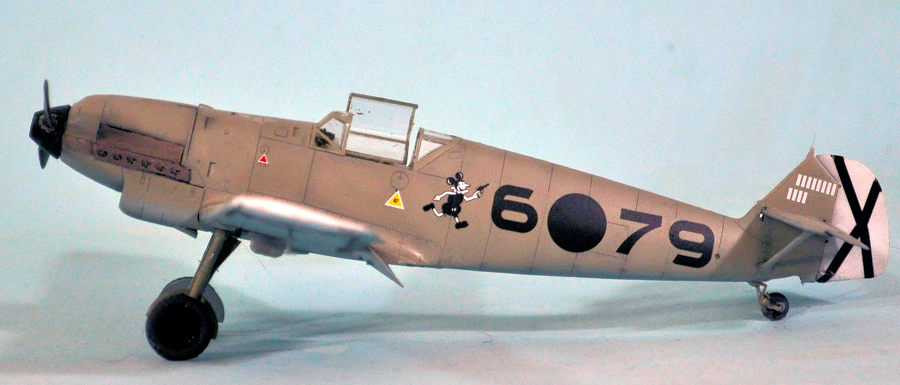
| KIT #: | 4806 |
| PRICE: | $50.00 SRP |
| DECALS: | Six options |
| REVIEWER: | Tom Cleaver |
| NOTES: | 2019 tooling |

| HISTORY |
Developed from the V10 and V13 prototypes,the Bf-109D was the last model of the Jumo powered 109s to enter service and it was built in larger numbers than the previous three subtypes combined. The Bf 109D was the standard version of the Bf 109 in service with the Luftwaffe just before the start of World War II. Despite this, the type saw only limited service during the war, as all of the 235 Bf 109Ds still in Luftwaffe service at the beginning of the Poland Campaign were rapidly taken out of service and replaced by the Bf 109E, except in some night fighter units where some examples were used into early 1940.
Variants included the D-0 and D-1 models, both having a Junkers Jumo 210D engine and armed with two wing-mounted and two nose- mounted 7.92 mm MG 17s. A total of 647 Bf 109Ds of all versions were built by Focke-Wulf, Erla, Fieseler, Arado and AGO.
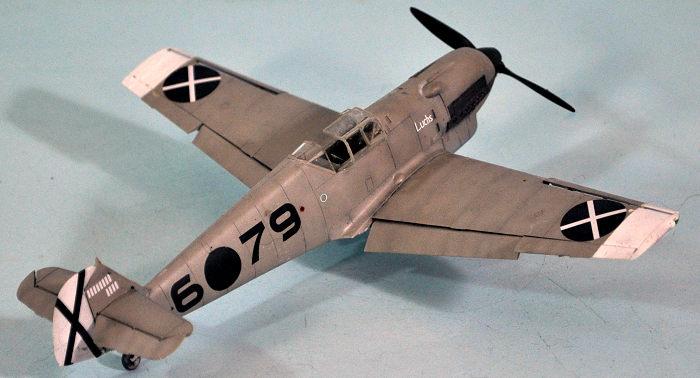 Messerschmitt is listed as having produced only four Bf 109Ds, probably
the D-0 preproduction series with the serial production transferred to the
licensed manufacturers. Several Bf 109Ds were sold to Hungary. Switzerland
bought 10 109D-1s (Serial Numbers from 2301 until 2310) which had been built by
the Arado- Flugzeugwerke GmbH factory located in Warnemünde.
Messerschmitt is listed as having produced only four Bf 109Ds, probably
the D-0 preproduction series with the serial production transferred to the
licensed manufacturers. Several Bf 109Ds were sold to Hungary. Switzerland
bought 10 109D-1s (Serial Numbers from 2301 until 2310) which had been built by
the Arado- Flugzeugwerke GmbH factory located in Warnemünde.
The Bf-109D saw its primary operational use in the Spanish Civil War, where it was operated by Jagdgruppe 88 of the Legion Condor.
The popular assumption is that Germany was drawn into Spain by the opportunity for testing and training for the Luftwaffe, but that was secondary. Hitler’s real reasons were strategic. The Condor Legion supported a fascist takeover of Spain, established a military challenge on the flank of France, opened access to seaports on the Atlantic, and distracted Europe from Germany’s own preparations for war.
The first Bf-109s supplied to Spain following the introduction of the Soviet I-15 and I-16 fighters that were clearly superior to the He-51s originally sent by Hitler were three prototypes, the V3, V4 and V6, which demonstrated the type was superior to its opponents. Sixteen Bf-109As were supplied in January and February 1937 and were operated by 2.J/88, commanded by Günther Lützow.the unit saw immediate action. In May, 26 Bf-109B-1s were supplied. Several went to 2.J/88 to bring it to strength while the others equipped 1.J/88, commanded by Harro Harder, which entered combat that fall. followed by five Bf-109C-1s in early 1938. In the spring of 1938, 35 Bf-109D-1s arrived in Spain, which went to replace losses in the first two staffeln, and to fully re-equip 3.J/88, led by Werner Mölders. On March 5, 1939, Hubertus von Bonin, who replaced Mölders as Staffelkapitän of 3/J/88 in November 1938, scored the last Bf-109 victory in the Spanish Civil War when he shot down an I-15 over Alicante.
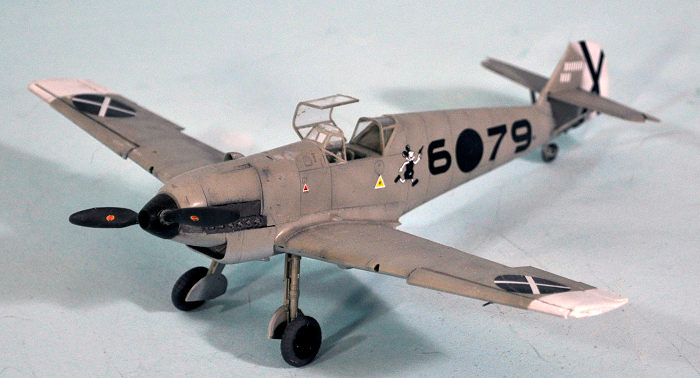 The top-scoring pilot of the Condor Legion was Werner Mölders, with a
total 14 victories scored during his year-long tour in 1937-38. Born on March
18, 1913 in Gelsenkirchen, the third of four children of Victor and Annemarie
Mölders, he had an older sister and brother, and a younger brother. Following
his father’s death on the Western Front on March 2, 1915, he was raised by his
mother. A Catholic, Mölders found a father figure in Chaplain Erich Klawitter,
who instilled firm religious beliefs in him.[
The top-scoring pilot of the Condor Legion was Werner Mölders, with a
total 14 victories scored during his year-long tour in 1937-38. Born on March
18, 1913 in Gelsenkirchen, the third of four children of Victor and Annemarie
Mölders, he had an older sister and brother, and a younger brother. Following
his father’s death on the Western Front on March 2, 1915, he was raised by his
mother. A Catholic, Mölders found a father figure in Chaplain Erich Klawitter,
who instilled firm religious beliefs in him.[
In 1931, Mölders became an officer cadet in the Preußisches Infanterieregiment Nr. 2. Successfully completing training, he was promoted to Fahnenjunker-Unteroffizier on April 1, 1932, and was then assigned to the Military School in Dresden, from which he graduated in June 1933 and was promoted to Ensign. He returned to the Pioneer Battalion of Infanterieregiment Nr. 2. In his first attempt to volunteer for flying duty, he was found to be constantly subject to airsickness and turned down. He mastered an ability to deal with the airsickness and passed on his second attempt.
Promoted to Oberfähnrich on February 1, 1934, Mölders began pilot training at the Deutsche Verkehrsfliegerschule in Cottbus, graduating on December 31, 1934. Promoted to Leutnant in March 1934 and assigned to the recently established Luftwaffe. Despite his airsickness, he graduated at the top of his class and was sent to the Jagdfliegerschule in Tutow from January to June 1935, at which time he Pilot's Badge of the Luftwaffe on May 21, 1935.
On July 1, 1935, Leutnant Mölders was posted to Fliegergruppe Schwerin (I./JG 162 "Immelmann"). On April 1, 1936, he was promoted to Oberleutnant and placed in command of the fighter training squadron of II/JG 134 "Horst Wessel,"commanded by World War I ace Major Theo Osterkamp, who became one of his mentors. Mölders was appointed Staffelkapitän of 1.JG 334 on March 15, 1937 and served as an instructor in Wiesbaden.
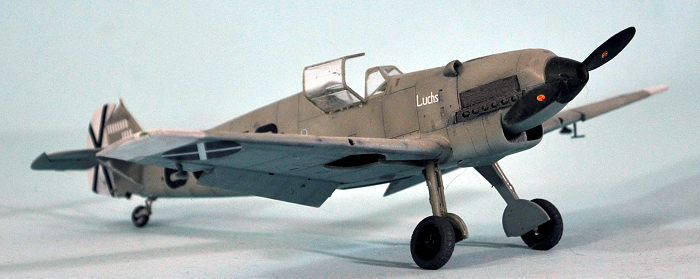 Mölders volunteered for service with the Legion
Condor, and arrived in Cadiz on April 14, 1938, assigned to 3.J/88 commanded by
Oberleutnant Adolf Galland on the
Valencia–Ebro front flying ground attack in He-51s. Mölders took command on May
24, when Galland returned to Germany and the squadron re-equipped with the
Bf-109D. He claimed an I-15 "Chato" near Algar, on July 15, 1938, for his fist
victory. Between then and November when he returned to Germany, he brought his
score to 14 to become the leading German ace of the Spanish Civil War. In
recognition of his exceptional performance as a commander and fighter pilot,
Mölders was promoted to Hauptmann on October 1, 1938. For his achievements in
Spain, Mölders was decorated with the Spanish Medalla de la Campaña and Medalla
Militar on May 4, 1939 and the German Spanish Cross in Gold with Swords and
Diamonds on June 6, 1939.
Mölders volunteered for service with the Legion
Condor, and arrived in Cadiz on April 14, 1938, assigned to 3.J/88 commanded by
Oberleutnant Adolf Galland on the
Valencia–Ebro front flying ground attack in He-51s. Mölders took command on May
24, when Galland returned to Germany and the squadron re-equipped with the
Bf-109D. He claimed an I-15 "Chato" near Algar, on July 15, 1938, for his fist
victory. Between then and November when he returned to Germany, he brought his
score to 14 to become the leading German ace of the Spanish Civil War. In
recognition of his exceptional performance as a commander and fighter pilot,
Mölders was promoted to Hauptmann on October 1, 1938. For his achievements in
Spain, Mölders was decorated with the Spanish Medalla de la Campaña and Medalla
Militar on May 4, 1939 and the German Spanish Cross in Gold with Swords and
Diamonds on June 6, 1939.
During his time in combat, Werner Mölders made perhaps the most important contribution to fighter combat when he created a new fighting formation that replaced the traditional “vic” of three fighters with leader and two wingmen, that had proved unwieldy with modern fighters, to what became known internationally as the “finger four,” combining two elements (rotte) of leader and wingman into the four-plane formation (schwarm), known as a “flight” in the USAF and RAF. This allowed the pilots to fly a looser formation that allowed them to watch for the enemy without fear of mid-air collision in the tight “parade ground” vic formation, while providing better coverage since the formation could split in two for mutual support. This formation was eventually adopted by every air force and used until the 1970s when the U.S. Air Force finally adopted the even-better U.S. Navy “loose deuce” formation in which the pilot who first sights the enemy takes the lead in the fight.
| THE KIT |
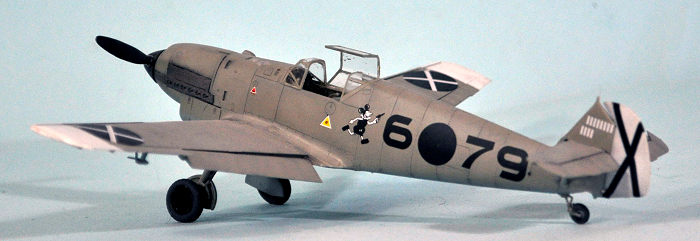 Modelsvit is one of several companies, the others being Dora Wings and
AMG that are under the umbrella of Mikro-Mir, which was previously known as
Amodel. Among the first products of the new companies was a series of early
109s, with Dora Wings and AMG releasing the Bf-109A and Bf-109B respectively,
while Modelsvit has now released the Bf-109C and Bf-109D. Outside of detail
differences like span of the leading edge slats and other items that
differentiate the sub-types, these are all the same kit.
Modelsvit is one of several companies, the others being Dora Wings and
AMG that are under the umbrella of Mikro-Mir, which was previously known as
Amodel. Among the first products of the new companies was a series of early
109s, with Dora Wings and AMG releasing the Bf-109A and Bf-109B respectively,
while Modelsvit has now released the Bf-109C and Bf-109D. Outside of detail
differences like span of the leading edge slats and other items that
differentiate the sub-types, these are all the same kit.
The Modelsvit Bf-109D includes markings for six different Bf-109Ds, including the airplane flown by Werner Molders, three different Luftwaffe units, a Swiss and a Hungarian unit.
| CONSTRUCTION |
At the time of the release of the Bf-109A and B, a well-known alleged experte modeler over at The Other Place declared the kits “very difficult” and published photos of his model with putty over every joint. That was not my experience with either the Dora Wings or AMG kits, or with this release from Modelsvit.
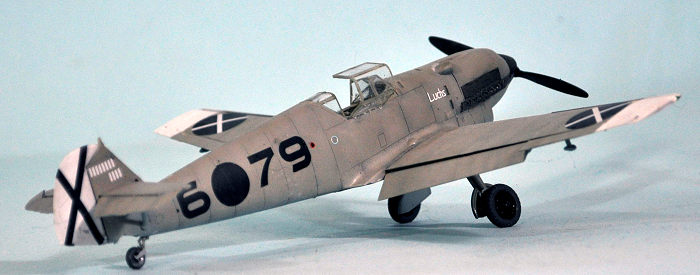 One needs to be aware that these are “limited run” kits, though of very
high-end quality, but still requiring a modelers to clean up the parts - paying
particular attention to getting rid of sprue nubs. If one also does careful
test-fitting and modifies the parts where necessary until satisfied with the fit
before gluing, the result will be a model that only requires putty along the
centerline of the upper cowling and the lower radiator. Ham-fisted model
construction of these kits will result in a putty monster (such a construction
style usually results in this).
One needs to be aware that these are “limited run” kits, though of very
high-end quality, but still requiring a modelers to clean up the parts - paying
particular attention to getting rid of sprue nubs. If one also does careful
test-fitting and modifies the parts where necessary until satisfied with the fit
before gluing, the result will be a model that only requires putty along the
centerline of the upper cowling and the lower radiator. Ham-fisted model
construction of these kits will result in a putty monster (such a construction
style usually results in this).
Again, committing the revolutionary act of following the instructions will, when combined with test-fitting and care in assembly before applying glue, lead to a very nice-looking model.
| COLORS & MARKINGS |
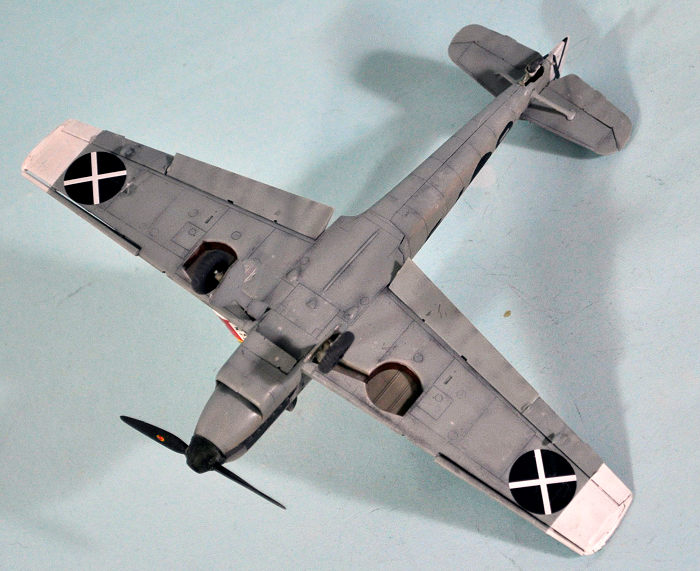 Most Bf-109Ds in Spain arrived in a camouflage of RLM63 gray upper
surfaces and RLM65 lower surfaces. RLM 63 is “close” to RLM02, so close it is
often mistaken for the better-known color. I mixed my version of this color from
Tamiya XF-63 “Deck Tan” to which I added around 5 percent Tamiya RLM02. I used
Tamiyas XF-23 “Light Blue,” which is RLM65. After painting the rudder and
wingtips white and masking them off, I pre-shaded the panel lines, then applied
the RLM65 to the lower surfaces. After applying the “RLM63", I added in some
white and went back over the upper surfaces to “fade them, as they would appear
after service in the hot Spanish sun. The prop was painted RLM-70, using Tamiya
XF-27 “Black-Green.”
Most Bf-109Ds in Spain arrived in a camouflage of RLM63 gray upper
surfaces and RLM65 lower surfaces. RLM 63 is “close” to RLM02, so close it is
often mistaken for the better-known color. I mixed my version of this color from
Tamiya XF-63 “Deck Tan” to which I added around 5 percent Tamiya RLM02. I used
Tamiyas XF-23 “Light Blue,” which is RLM65. After painting the rudder and
wingtips white and masking them off, I pre-shaded the panel lines, then applied
the RLM65 to the lower surfaces. After applying the “RLM63", I added in some
white and went back over the upper surfaces to “fade them, as they would appear
after service in the hot Spanish sun. The prop was painted RLM-70, using Tamiya
XF-27 “Black-Green.”
I used the kit decals to do Mölders’ Bf-109D-1 of 3./J88. The decals performed without trouble and went down nicely under Solvaset.
I gave the model an overall coat of clear flat, then applied exhaust and gunfire stains with Tamiya “Smoke.”
The landing gear and prop were attached and the canopy mounted in the open position.
| CONCLUSIONS |
Until Eduard decides to do early 109s, these kits from Dora Wings, AMG and Modelsvit are the best early 109 kits available in 1/48. They create no problems for a modeler who takes his or her time in test-fitting, and look very good sitting next to any other company’s 109s on the shelf. Not for beginners, but any modeler with average experience should have no trouble. Highly recommended.
18 June 2020
Copyright ModelingMadness.com
Review Kit courtesy of my wallet.
If you would like your product reviewed fairly and fairly quickly, please contact the editor or see other details in the Note to Contributors.
Back to the Main Page Back to the Review Index Page Back to the Previews Index Page